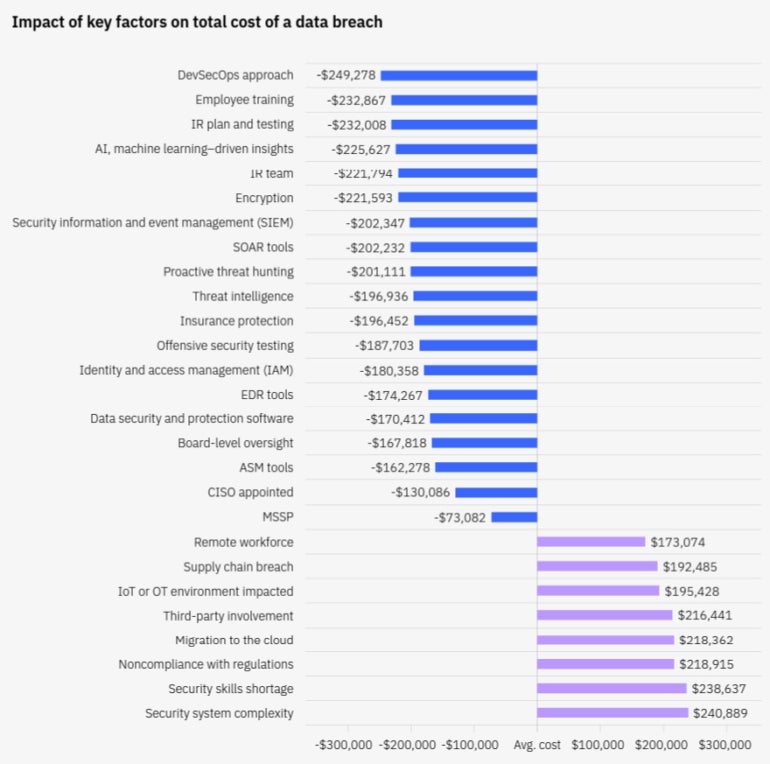
 Image: Creativa Images/Adobe Stock There’s a great reason Australian organizations are more mindful than ever of the threat of a data breach in 2023. In the last few years senior IT specialists, together with many daily Australians, have witnessed a variety of high profile events, consisting of the shock hacking of big regional telecommunications company Optus and leading health insurance provider Medibank.
Image: Creativa Images/Adobe Stock There’s a great reason Australian organizations are more mindful than ever of the threat of a data breach in 2023. In the last few years senior IT specialists, together with many daily Australians, have witnessed a variety of high profile events, consisting of the shock hacking of big regional telecommunications company Optus and leading health insurance provider Medibank.
Organizations are likewise more familiar with the expense. According to IBM’s Expense of a Data Breach Report 2023, the average expense of a data breach in Australia has grown by 32% in 5 years to AU $4.03 million (United States $2.57 million). This is being led by the monetary services sector, with a typical breach cost of AU $5.56 million (United States $3.55 million), followed by the tech and education sectors at AU $5.06 million (United States $3.23 million) and AU $4.61 million (United States $2.94 million) respectively.
As the risk of data breach events increase, IT leaders are in a position to decrease the cost of an information breach by carrying out DevSecOps, using AI and automation, prioritizing incident response preparation and testing, simplifying data breach discovery and taking out adequate cybersecurity insurance for when the worst happens.
Dive to:
What does the Australian data breach landscape look like in 2023?
Massive data breaches have actually been a feature of news headlines in Australia in the last few years.
In September 2022, the hack of local telecoms company Optus saw cybercriminals steal the individual data, including identity documents, of 9.8 million Australians in an occurrence that lots of declared woke Australia up to the threat of cybercrime. The event, which affected a large portion of the population, resulted in Optus being the topic of a class action claim and Optus being labeled the least trusted brand in Australia by marketing research company Roy Morgan.
This was followed in the same year by an equally high-profile attack on big local health insurance company Medibank. This attack led to hackers putting the details of 9.7 million existing and previous Medibank consumers on the dark web. Other recent breaches include an attack on monetary services firm Latitude Financial in March 2023– the largest information breach in Australia’s history– which exposed the personal info of 14 million past and present customers.
SEE: Discover more about how data breaches are impacting the healthcare industry.
Must-read security coverage
The Office of the Australian Details Commissioner’s September 2023 report on Australia’s Notifiable Data Breach plan found there were 409 information breach notifications from January to June 2023. This was down 16% on the previous 6 months, despite the period including Australia’s most significant information breach and the most data breaches recorded in a month (100 alerts in March). Many breaches (70%) were harmful or criminal attacks. Human mistake led to 107 alerts, 46% of which were brought on by an email being sent to the wrong individual.
As the National Data Breach scheme does not record foreign organizations running in Australia, the actual impact of breaches on Australian clients could be much larger.
How much have information breach costs been increasing in Australia?
Australia has experienced a 32% spike in data breach costs over five years to AU $4.03 million (United States $2.57 million). IBM’s 2023 research study report, carried out by Ponemon Institute, found detection and escalation expenses have actually reached AU $1.68 million (US $1.07 million)– the highest portion of regional breach expenses– indicating a shift towards more intricate breach examinations.
Data that was breached was most often kept across multiple types of environments (32%), followed by personal cloud (28%) and on-premises (21%). The 2 most common attack types were phishing rip-offs (over 22%) and taken or compromised credentials (over 17%).
Although mega breaches like Optus, Medibank and Latitude Financial are fairly rare, they are much more expensive than typical information breach costs. The IBM report found that, worldwide, the expense of a mega breach of between one million and 10 million records cost organizations around United States $36 million, while a breach of between 10 million to 20 million records could leave companies with a total breach expense of up to United States $166 million.
In general, Australia is the 13th nation or region worldwide when ranked by data breach expenses. IBM discovered the global typical expense of an information breach has reached an all-time high of US $4.45 million. The average expense increased by 15.3% from US $3.86 million in 2020, with the U.S. experiencing the highest typical data breach expense of $9.48 million, followed by the Middle East (United States $8.07 million) and Canada (US $5.13 million). The typical expense per record involved in a data breach has actually risen from US $146 in 2020 to US $165 today.
What costs can you anticipate to sustain due to a data breach?
The total instant and longer tail costs of a data breach are hard to approximate. IBM utilizes an activity-based costing method that breaks down expenses along the four common stages of the information breach life process, based on comprehensive research study on genuine information breaches. These phases consist of detection and escalation, notice, post-breach reaction and lost business.
- Detection and escalation: These costs consist of investigative activities, assessment and audit services, crisis management and interactions to executives and boards.
- Notification activities: Decision of regulatory requirements, interaction with regulators, engagement of professionals and communications are the costs in this stage.
- Post-breach reaction: Assist desks, credit monitoring and identity protection services, providing new accounts or credit cards, legal costs, product discount rates and fines.
- Lost company: These expenses include trying to reduce loss of clients, the cost of obtaining brand-new ones, continuous reputational damage and lessened goodwill.
Following the Optus and Medibank information breaches in 2022, Australia introduced a brand-new Privacy Act modification that could make data breaches more expensive in the future. The Personal Privacy Legislation Change (Enforcement and Other Steps) Bill, which was targeted at companies that stop working to take sufficient care of their customer data, raised the optimum charges for serious or duplicated privacy breaches from AU $2.22 million to AU $50 million.
How can Australian business decrease information breach costs?
The decisions IT and business leaders make, as well as the methods they release around their information and security, can heavily influence the expense they pay if a data breach does take place (Figure A).
Figure A
 There are many elements that affect the monetary effect
There are many elements that affect the monetary effect
of a data breach. Image: IBM Having the right cybersecurity abilities in your organization– or tapping external partners for this proficiency– can likewise help reduce data breach costs. IBM’s report determines a variety of aspects present in companies that are most likely to lower the expense of a breach. On the other hand, not implementing them can result in higher breach costs.
Speed up DevSecOps adoption
A high level of DevSecOps adoption led to the largest expense savings during information breaches all over the world. Since it positions an emphasis on security screening as part of the software application advancement process, organizations with high DevSecOps adoption saved United States $1.68 million compared to those with low or no adoption.
Aim for a much shorter breach life cycle
Organizations that wish to reduce expenses ought to aim to keep breach life cycles short, as the time to solve an occurrence is essential to financial impact. Breaches with identification and containment times under 200 days cost companies United States $3.93 million, while those over 200 days cost US $4.95 million– a difference of 23%.
SEE: How to avoid a data breach by protecting data in transit.
Release security AI and automation
AI and automation had the greatest impact on the speed of breach recognition and containment. IBM found Australian companies that did not utilize security AI and automation in combating cyber threats experienced breaches costing usually AU $2.14 million more than those that deployed these innovations thoroughly.
Focus on incident action preparation
Expense cost savings were accomplished by organizations with greater levels of IR planning and testing. Organizations with high levels of IR preparation and screening saved US $1.49 million compared to those with low levels. The IBM report found that IR preparation and testing was an extremely effective method for consisting of the cost of an information breach.
Hire police
Leaving out police from a ransomware incident in particular can result in a higher ultimate cost from the information breach. IBM’s results discovered that, while 63% of participants said they included law enforcement in a ransomware occurrence, the 37% that didn’t paid 9.6% more and experienced a 33-day longer breach life process.
Consider buying cyber insurance coverage
While not a replacement for cybersecurity maturity and readiness, cyber insurance can assist organizations directly cover the cost of information breach occurrences, consisting of forensic investigations, information remediation, client notification and rectification along with indemnification of charges imposed by federal government regulators. That said, the Insurance coverage Council of Australia stated just 35%– 70% of bigger organizations had actually standalone cyber insurance in 2022.
Taking a proactive method to data breach expense decrease
An intriguing finding from IBM’s Cost of an Information Breach Report 2023 was that, among companies that suffered a data breach around the globe, just 51% were preparing to increase cybersecurity financial investments as an outcome. In reality, a most likely outcome is that the costs of a data breach will end up being handed down to an organization’s consumers: 57% of participants said information breaches caused a subsequent boost in the pricing of their business offerings.
The most obvious method for Australian IT leaders to minimize data breach costs, consisting of to their brand name and credibility, is to prevent a breach from ever happening. There’s no doubt organizations with a mature cybersecurity posture are the most likely to avoid attacks– or discover them rapidly. Nevertheless, even fully grown companies have no reason to relax; just a 3rd of attacks IBM investigated were determined by a company’s internal teams and tools.




